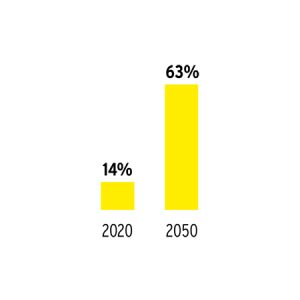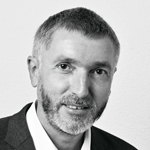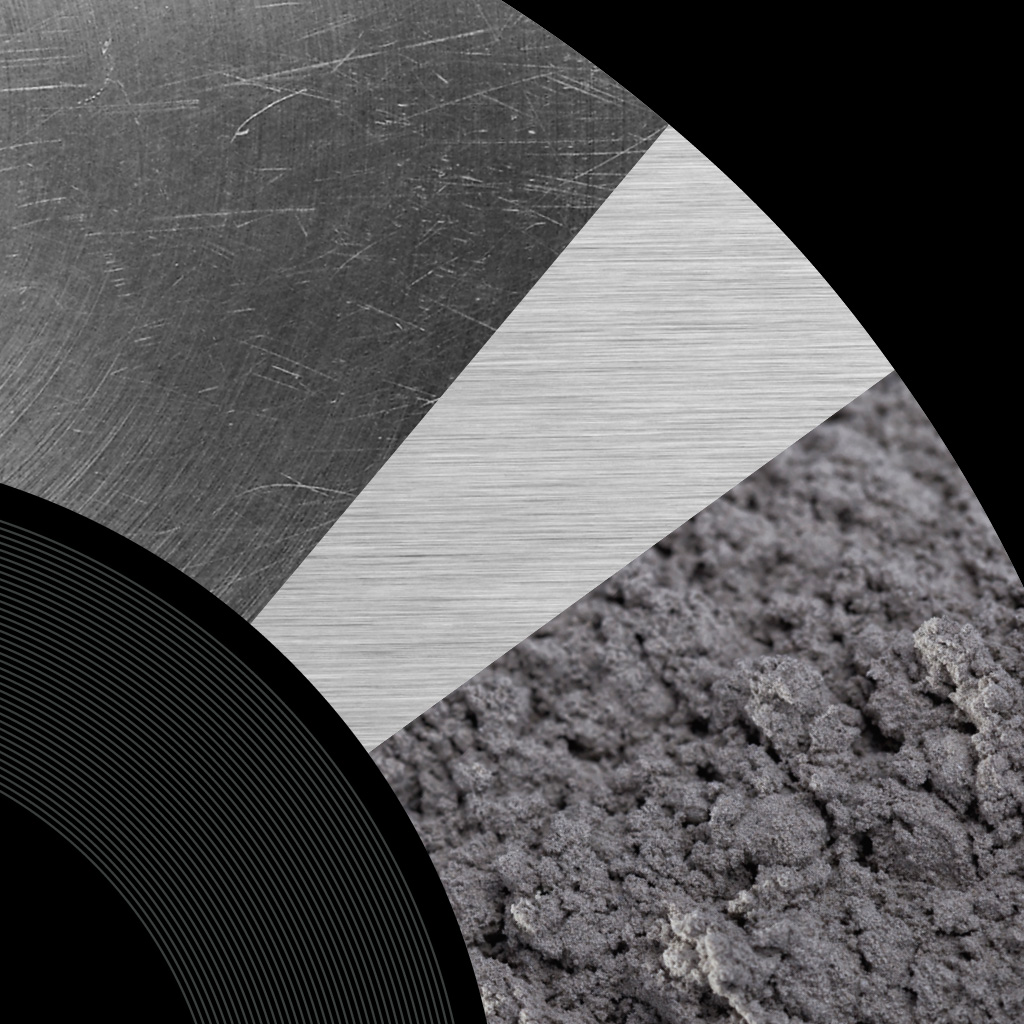In order to save CO2, the raw materials industry must reorganize its production processes and satisfy its fierce appetite for energy from power grids. But it is only by working together that grid operators and industry specialists will ensure power quality in the future.
To slow the rate of climate change, suppliers, grid operators, and grid planners worldwide must make massive efforts to substitute fossil fuels with renewables. Depending on the circumstances, grids will need to transport about 50% more electricity by 2040, amounting to a range between 38,000 and 41,000 TWh (see ONLOAD 07). However, the energy transition challenge can only be met if all major consumers work toward the same goal.
22 %
of global CO 2 emissions are caused by the production of steel (10%), aluminum (4%), and cement (8%) alone. If climate change is to be stopped, we urgently need to change how we produce raw materials.
According to grid specialist Dr Stephan Rupp, Business Development Manager for Power Electronics at Reinhausen and professor at the Center for Advanced Studies at the Baden-Württemberg Cooperative State University, three industries are particularly affected by this change: “The energy-intensive production of steel, aluminum, and cement releases more than eight billion metric tons of CO2every year. This accounts for a total of more than 22 percent of global emissions of what is effectively a climate killer. The next few years will see a sweeping revolution in this field which will have drastic effects on power grids.”
UP TO 95 PERCENT LESS CO2
At 3.5 billion metric tons of CO2, steel production alone is responsible for around ten percent of total annual emissions. “In addition to the pressure to drastically reduce carbon dioxide emissions, possible raw material shortages are also forcing the industry to rethink its strategies,” Stephan Rupp reports. “If production levels were to remain at the current figures, global supplies of iron ore could be exhausted in around 70 years,” he adds. At present, 70 percent of the steel produced each year comes from primary reserves—in other words ore. However, projections show that the world’s appetite for steel is growing steadily, which is rapidly exacerbating the situation.
LET’S TAKE STEEL AS AN EXAMPLE
CO2 emissions per metric ton of steel by process step:
- Pre-processing of ore (sinter material, pellets) and coke production: approx. 1.2 metric tons
- Iron production: Reduction of ore (iron oxide) to pig iron using carbon: approx. 1 metric ton
- Steel production from melting furnaces with oxygen injection (mainly from pig iron): approx. 0.8 metric tons
- Steel production from electric arc furnaces (mainly from scrap metal): approx. 0.3 metric tons
With regard to the conflict caused by the scarcity of raw materials and the need for a climate-friendly restructuring of production methods, Stephan Rupp suggests a solution involving establishing material cycles and simultaneously converting production plants to use larger proportions of scrap metal. And all of this must naturally include the use of renewable energies. “To achieve this goal, more and more conventional melting furnaces will have to be replaced in the future by electric arc furnaces that draw electricity from renewable energy sources,” he explains.
“Depending on the process used, the industry could potentially save between 40% and 95% of CO2 emissions.”Dr. Stephan Rupp
“The increasing use of scrap metal also eliminates a proportion of the emissions caused by the energy-intensive extraction of pig iron from ore. This would mean that this part of the production chain would already be virtually free of emissions. Depending on the process used, the industry could potentially save between 40% and 95% of CO2 emissions.”
CEMENT PRODUCTION
Hot on the heels of the steel industry, the construction sector is another big industrial contributor to climate change. Global cement production currently amounts to more than 4.6 billion metric tons per year which releases approximately three billion metric tons of CO2. This is equivalent to around eight percent of global emissions— more than the combined share caused by air traf- more than the combined share caused by air traf more than the combined share caused by air traffic and data centers. To produce cement, limestone, sand, and clay are crushed and ground in gigantic plants and burned at more than 1,400 degrees.

This process produces a lot of CO2, which has a major impact on climate change and which could easily be significantly reduced by using renewable sources of energy. “Admittedly, the majority of the total emissions are linked to the cement production itself: As a raw material, limestone contains vast amounts of CO 2 that are released during processing. Nevertheless, this step already improves the industry’s carbon footprint by a quarter. This footprint can be optimized even further to 0.6 metric tons of CO2 per ton of cement by implementing new production methods as well as capturing and storing CO2 process emissions,” explains Reinhausen’s specialist Stephan Rupp.
MORE DYNAMIC GRID FEEDBACK
Aluminum mining and production also requires enormous amounts of energy and is therefore damaging to the environment. Only 65 million metric tons of this light metal are produced worldwide in comparison to the larger quantities of steel and cement. However, the process consumes massive amounts of energy: The aluminum oxide is mined at great expense and then reduced to aluminum in aluminum smelters using an electrolysis process that requires 15,7 MWh of energy per metric ton.
The annual production of aluminum from ore releases more than 1.3 billion tons of CO2 per year. This corresponds to about four percent of global CO2 emissions today. Potential savings could be made here with regard to fuel emissions in particular by using green electricity for electrolysis and by increasing the proportion of scrap metal in the material cycle. The latter solution proves to be particularly worthwhile, with a whopping 95 percent of emissions saved compared to smelting. In fact, 20 million metric tons of aluminum are already produced from scrap metal today. What does this development mean for our grids?
“Grid feedback will increase due to dynamic and unbalanced loads. This in turn will increase the demands placed on the industry to build modern grid infrastructures.” Thomas Röseler
In the industry segment as a whole, electrical energy currently accounts for around 14 percent of total energy consumption. IRENA (International Renewable Energy Agency) estimates that this share is expected to grow to more than 63 percent by 2050 with plants expected to generate about 40 percent themselves (solar, biomass, process heat), while obtaining the rest from power grids.
Thomas Röseler, Head of Innovation and Projects for a number of future grid stabilization projects at Reinhausen, reports: “With their rotating generators, thermal power plants still play a decisive role when it comes to ensuring stable frequency quality and power quality. However, these will be considerably reduced over the next two decades and replaced by volatile sources. At the same time, grid feedback will increase due to dynamic and unbalanced loads, such as those generated by large consumers like electric arc furnaces. This in turn will increase the demands placed on the industry to build modern grid infrastructures.”
SECURING COMPANY GRIDS
According to Thomas Röseler, the change in energy systems is gaining even more ground among consumers: Classic drive technologies, for example in mining or compressor drives for gas liquefaction plants (LNG), are being replaced by power electronic systems with a power range of up to 100MW. And also in this regard, the flow of energy is becoming increasingly bidirectional. The future will no longer rely on a single generator, but on a multitude of dispersed producers, some of which will be operated by the manufacturing companies themselves. “All of these changes on both the production and consumption sides have an impact on power quality which needs to be harmonized,” underlines the Head of Innovation.

And as Thomas Röseler points out, this needs to start right from the planning phase. In addition to knowledge about supply structures, grid planners also require an indepth understanding of the customer’s technology to create corresponding infrastructures and provide equipment. This means that planners are often caught between the expectations of consumers (such as steel, cement, or aluminum and copper producers) and the requirements of suppliers. “In the future, planners will need a lot of expertise in building and protecting company grids—depending on the technology used by consumers —to ensure the connection conditions,” explains Thomas Röseler.
Both supply processes and customer technologies are placing ever higher demands on power quality and supply reliability. For example, it is increasingly necessary to compensate for reactive power and reduce harmonics in industrial distribution grids. However, the MR specialist goes on to say that individual solutions are also needed at the medium and high-voltage level, for example to improve the grid stability at critical nodes.
“To prevent voltage drops and fluctuations such as flicker, or to provide dynamic reactive power, consumers will require more tried-and-tested systems to compensate for reactive power; filter circuit systems for harmonics; and dynamic reactive power compensation systems to stabilize the line voltage. Those are just a few of the challenges facing producers and grid operators down the line.”
REINHAUSEN INSIDE
Solutions to improve power quality and reactive power compensation will be vital in the grids of the future. A crucial role is played by filter circuit systems for harmonics as well as by dynamic reactive power compensation systems to stabilize the line voltage.
Maschinenfabrik Reinhausen has extensive expertise when it comes to planning and supplying suitable systems that ensure, on the one hand, seamless production and, on the other, compliance with the requirements for grid connection.
IYOUR PERSONAL CONTACT

Do you have any questions?
Thomas Röseler:
T.Roeseler@reinhausen.com

Dr. Stephan Rupp:
S.Rupp@reinhausen.com
